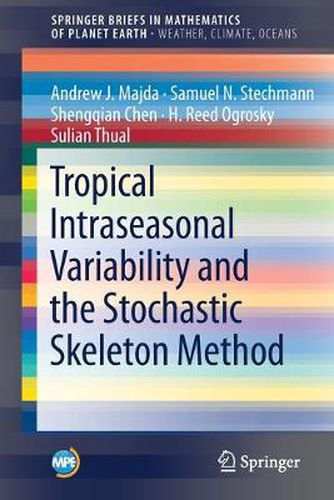Readings Newsletter
Become a Readings Member to make your shopping experience even easier.
Sign in or sign up for free!
You’re not far away from qualifying for FREE standard shipping within Australia
You’ve qualified for FREE standard shipping within Australia
The cart is loading…






This title is printed to order. This book may have been self-published. If so, we cannot guarantee the quality of the content. In the main most books will have gone through the editing process however some may not. We therefore suggest that you be aware of this before ordering this book. If in doubt check either the author or publisher’s details as we are unable to accept any returns unless they are faulty. Please contact us if you have any questions.
In this text, modern applied mathematics and physical insight are used to construct the simplest and first nonlinear dynamical model for the Madden-Julian oscillation (MJO), i.e. the stochastic skeleton model. This model captures the fundamental features of the MJO and offers a theoretical prediction of its structure, leading to new detailed methods to identify it in observational data. The text contributes to understanding and predicting intraseasonal variability, which remains a challenging task in contemporary climate, atmospheric, and oceanic science. In the tropics, the Madden-Julian oscillation (MJO) is the dominant component of intraseasonal variability.
One of the strengths of this text is demonstrating how a blend of modern applied mathematical tools, including linear and nonlinear partial differential equations (PDEs), simple stochastic modeling, and numerical algorithms, have been used in conjunction with physical insight to create the model. These tools are also applied in developing several extensions of the model in order to capture additional features of the MJO, including its refined vertical structure and its interactions with the extratropics.
This book is of interest to graduate students, postdocs, and senior researchers in pure and applied mathematics, physics, engineering, and climate, atmospheric, and oceanic science interested in turbulent dynamical systems as well as other complex systems.
$9.00 standard shipping within Australia
FREE standard shipping within Australia for orders over $100.00
Express & International shipping calculated at checkout
This title is printed to order. This book may have been self-published. If so, we cannot guarantee the quality of the content. In the main most books will have gone through the editing process however some may not. We therefore suggest that you be aware of this before ordering this book. If in doubt check either the author or publisher’s details as we are unable to accept any returns unless they are faulty. Please contact us if you have any questions.
In this text, modern applied mathematics and physical insight are used to construct the simplest and first nonlinear dynamical model for the Madden-Julian oscillation (MJO), i.e. the stochastic skeleton model. This model captures the fundamental features of the MJO and offers a theoretical prediction of its structure, leading to new detailed methods to identify it in observational data. The text contributes to understanding and predicting intraseasonal variability, which remains a challenging task in contemporary climate, atmospheric, and oceanic science. In the tropics, the Madden-Julian oscillation (MJO) is the dominant component of intraseasonal variability.
One of the strengths of this text is demonstrating how a blend of modern applied mathematical tools, including linear and nonlinear partial differential equations (PDEs), simple stochastic modeling, and numerical algorithms, have been used in conjunction with physical insight to create the model. These tools are also applied in developing several extensions of the model in order to capture additional features of the MJO, including its refined vertical structure and its interactions with the extratropics.
This book is of interest to graduate students, postdocs, and senior researchers in pure and applied mathematics, physics, engineering, and climate, atmospheric, and oceanic science interested in turbulent dynamical systems as well as other complex systems.